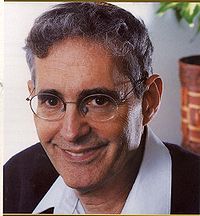Prof. Adrian Bird from the University of Edinburgh, Prof. Haim Sider and Prof. Aharon Razin from the Hebrew University are nominated for the prize for their research on DNA methylation and gene expression, but the members of the prize committee may be confused between the Herceptin discoverer and the cell recycling researchers

So far, Israelis have won Nobel Prizes in chemistry, economics, as well as in the non-scientific fields - literature and peace. Two fields have not yet been represented - physics and medicine, although it can be said that the Nobel Prizes in Chemistry won by Avraham Hershko and Aharon Chakhanover as well as Prof. Ada Yonat are on the border of the medical field.
Two researchers from the Hebrew University Prof. Haim Sider and Prof. Aharon Razin together with their colleague Prof. Adrian Bird from the University of Edinburgh share one of the fields that may win the Nobel Prize for Medicine next week. This is according to the forecast made by the Thompson-Reuters company every year. It should be noted that the forecasts, which annually bring the fields that have reached their conclusion and are eligible for the Nobel Prize, do not necessarily predict and the members of the various Nobel committees may surprise. For example, the British Society predicted the winning of Prof. Yakir Aharonov from Tel Aviv University with the Nobel Prize in Physics a few years ago, and after he did not win, his name was never mentioned again.
see also:
- A spotlight on epigenetics - Scientific American
- Prof. Haim Sider won the 2011 Rothschild Prize
- Researchers from the Hebrew University have revealed the mechanism that transforms embryonic stem cells into adult cells
Why doesn't every cell get access to all the genes?
Prof. Adrian Bird from the University of Edinburgh, Prof. Haim Sider and Prof. Aharon Razin from the Hebrew University are nominated for the award for their research on DNA methylation and gene expression. Every cell in our body contains all the genetic information to build the entire body, but when the embryo begins to divide and develop, the future of each cell type becomes more and more limited. Although the DNA instructions do not change, they continue to be uniformly distributed over every cell in the body, but each cell gets limited access to the instructions it does not need. For example, the liver cells get access only to the genes relevant to them, while nerve cells do not get access to these genes. The editing or branding is the result of epigenetic processes.
Prof. Cedar and Prof. Razin have been researching the phenomenon jointly at the Hebrew University for the past thirty years, and discovered for the first time exactly how these switches work. Adrian Bird deepened the understanding of the methylation process and discovered that there are two different types of methylation.
We asked for the Hebrew University's response, but the spokeswoman's office stated that the two are not being interviewed during the evaluation phase. If and when they win they will give their response.
Cellulose waste recycling
Daniel Kilonsky from the University of Michigan in the USA, Noburo Mitsushima from the University of Tokyo in Japan and Yoshimori Ohsumi from the Tokyo Institute of Technology in Yokohama - Japan.
autophagosomes - autophagosomes (literally self-eating organelles). In the XNUMXs, researchers described a phenomenon known as autophagy. Inside the cells, small vesicles will surround organelles such as mitochondria or cytoplasmic fragments and transport them to the lysosome, where they undergo degradation. Prof. Oshumi was the first to discover that cells break down their own parts for recycling. With this knowledge, Prof. Mitsushima later discovered that autophages also have a role in the normal cycle of the cell - especially in embryos. Kilonsky discovered the protein that regulates the process.
Herceptin developer
Another possible category this time contains a single candidate - Prof. Dennis Salamon from the University of California in Los Angeles who discovered the cancer gene HER-2/neu oncogene, a discovery that led to more effective treatments against cancer. Thanks to the work of Salmon and his colleagues, one of the deadliest forms of breast cancer has become manageable. Salamon was one of the pioneers in the development of Herceptin, which acts against growth factor 2 in the human epidermis - the active protein in this disease.

2 תגובות
Did you not find a more recent picture?
Successfully. crossing fingers